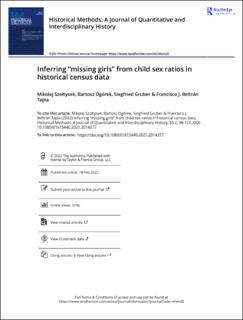| dc.contributor.author | Szoltysek, Mikolaj | |
| dc.contributor.author | Ogórek, Bartosz | |
| dc.contributor.author | Gruber, Siegfried | |
| dc.contributor.author | Beltrán Tapia, Francisco Javier | |
| dc.date.accessioned | 2023-02-24T09:46:03Z | |
| dc.date.available | 2023-02-24T09:46:03Z | |
| dc.date.created | 2022-02-21T17:56:34Z | |
| dc.date.issued | 2022 | |
| dc.identifier.citation | Historical Methods. 2022, 1-25. | en_US |
| dc.identifier.issn | 0161-5440 | |
| dc.identifier.uri | https://hdl.handle.net/11250/3053789 | |
| dc.description.abstract | The topic of “missing girls” in historical Europe has not only been mostly neglected, but previous research addressing this issue usually took the available information too lightly, either rejecting or accepting the claims that there was discrimination against female children, without assessing the possibility that the observed child sex ratios could be attributable to chance, mortality differentials, or registration quality. This article contributes to this discussion by (1) using a novel dataset of historical child sex ratios that covers a large part of the European geography between 1700 and 1926; and (2) explicitly considering the effects of random variability, demographic variation, and faulty enumeration in the analysis. Our results provide evidence that some of these European populations had child sex ratios well above the levels usually considered “natural”. Although part of this variation is indeed shown to be due to random noise and structural features related to infant mortality differentials and census quality, some of the observed sex ratios are too high to be attributed solely to these proximate factors. Thus, these findings suggest that there are behavioural explanations for some of the unbalanced sex ratios observed in our data. | en_US |
| dc.language.iso | eng | en_US |
| dc.publisher | Informa UK Limited | en_US |
| dc.rights | Attribution-NonCommercial-NoDerivatives 4.0 Internasjonal | * |
| dc.rights.uri | http://creativecommons.org/licenses/by-nc-nd/4.0/deed.no | * |
| dc.title | Inferring “missing girls” from child sex ratios in historical census data | en_US |
| dc.title.alternative | Inferring “missing girls” from child sex ratios in historical census data | en_US |
| dc.type | Peer reviewed | en_US |
| dc.type | Journal article | en_US |
| dc.description.version | publishedVersion | en_US |
| dc.source.pagenumber | 1-25 | en_US |
| dc.source.volume | 55 | en_US |
| dc.source.journal | Historical Methods | en_US |
| dc.source.issue | 2 | en_US |
| dc.identifier.doi | 10.1080/01615440.2021.2014377 | |
| dc.identifier.cristin | 2004253 | |
| dc.relation.project | Norges forskningsråd: 301527 | en_US |
| cristin.ispublished | true | |
| cristin.fulltext | original | |
| cristin.qualitycode | 2 | |

